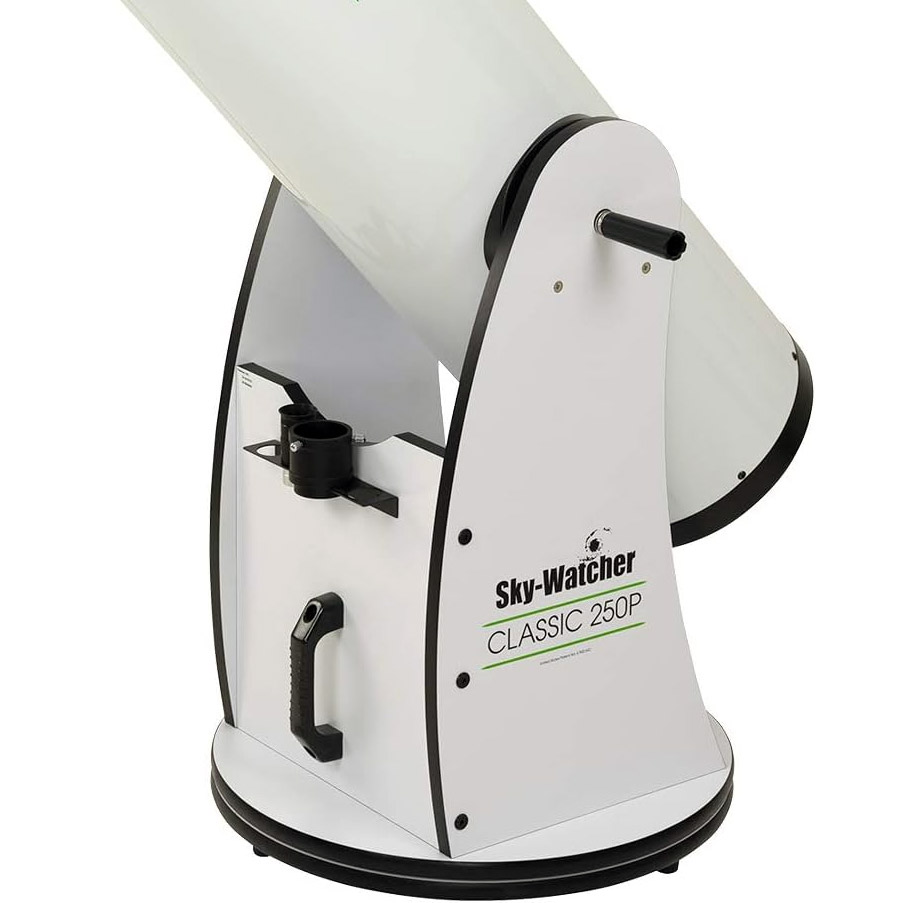Telescope mounts are the most often overlooked feature beginners look at when choosing a telescope. But it is a critical decision.
The mount controls the movement of the telescope. It is the part of the telescope that you will be adjusting the most, and therefore, it is going to determine a lot about the experience that you will have while using it.
Understanding the types of telescope mounts that are out there can seem intimidating. No one did them any favors by choosing their names. I mean, “Alt-Azimuth”? what is that supposed to mean?
This is why I have written this article explaining everything that you need to know about them. As you will see, they are quite easy to understand and the advantages and disadvantages of each are very obvious. Hopefully, this guide will help you make a more informed decision so you can choose the telescope that is right for you.
What is the telescope mount and what does it do?
If you are already familiar with the use of a mount, you can skip this section.
A telescope mount has three primary functions.
First, it connects the tripod to the tube of the telescope. Most amateur and mid-range telescopes come with a bundled mount so you don’t need to worry about anything. However, if you are looking for an astrophotography telescope or a high-end model, those often don’t come with one so you have more freedom to choose whichever one you want. In that case, you will need to make sure the mount connector is compatible with the tube you’ll be using.
Second, the mount supports the weight of the tube. As a result, it is going to play an important part in how sturdy a telescope feels when you are using it. This is important because when you are using high magnifications the slightest movement can result in a violent move in the image you are looking at. A good mount needs to be made out of solid materials and have precise, tight screws.
Finally, and most importantly, the mount is also the control of your telescope. You are going to be using the mount to turn, adjust, and point the telescope.
Telescope mount types
There are two main types of telescope mounts, Alt-azimuth Mounts and Equatorial Mounts. Both are widely used and choosing the one that is best for you is going to depend on factors such as your stargazing experience, how easy you want the controls to be, and the size and weight of the telescope tube. All other types of mounts are based of these two.
While telescope mounts can be replaced and upgraded, it is generally not worth the money to do so, at least when it comes to amateur and hobbyst-grade telescopes. For the money you’d spend it usually is a better choice to simply get a brand new telescope that comes bundled with the type of mount that you want.
This is why it is important to weigh the pros and cons of each telescope mount type and choose the one that better fits the kind of use that you’ll be giving to your device.
For the most part, certain mounts are tied to specific types of telescopes, for example, Dobsonian mounts are only used for Dobsonian telescopes. While some are interchangeable, telescopes usually come bundled with the type that better fits their use case.
That being said, let’s really get to the list of types of telescope mounts.
Alt-Azimuth mount

Alt-Azimuth mounts or AZ mounts for short, are the most basic and popular type of mount. The “Alt” stands for “altitude”.
AZ mounts are basically “point and shoot”. Just move the lever in the direction you want and you are done. They require no alignment, counter-weights, or complicated setups. As a matter of fact, some professional photography tripods come with an AZ mount so if you have ever seen or used one, you already know how they work.
These mounts usually connect to the tube using just one arm. The control is a single lever that can move up-down, and left-right. Usually, the left-right movement will allow you to freely rotate the tube 360 degrees while the up-down will be more limited depending on the specific model.
Funnily enough, Alt-Azimuth mounts are used in the two extremes of the telescope use cases. They are recommended for beginners because they are very intuitive and easy to use, and they are also used in very large telescopes and even giant observatories because the alternatives are very hard to manufacture at scale.
Alt-Azimuth mounts are recommended for beginners and usually come bundled with entry-level refracting telescopes. Kid’s telescopes also come with these because they are much easier to use. They also tend to be cheaper and lighter so they are also good for portable scopes.
There are two disadvantages to AZ mounts
- They are not as precise as EQ mounts
- It is really hard to track moving objects
Equatorial mounts

The main benefit of equatorial mounts is that they use polar alignment to semi-automatically stay fixed on an object. This allows you to track an object throughout long stargazing sessions more easily and some motorized EQ mounts can even do it automatically.
This feature, however, adds a bit of setup to your process, because every time you want to use the telescope, you will first need to align one of its two axis to the celestial pole. This sounds more complicated than it really is and it takes just 3 to 5 minutes once you get the hang of it. Aligning this axis means that the other axis and the tube of your telescope will be able to move along with the movement of the stars throughout the night.
Equatorial mounts were also designed to find objects in the sky more easily by using the declination and right ascension of an object. These are two “coordinates” that mark the position of an object in the sky. In any EQ telescope, you will find controls to set them. While this method used to be widely used, it took a long time and is a bit complicated. These days you can simply download a star map app on your phone that makes things a lot easier.
One more thing you’ll notice when looking at an EQ mount is a metallic bar with discs attached to the end that sits opposite to the tube. These are counterweights and their function is to keep the telescope stable because the EQ mount can be rotated into positions where the tripod is not fully supporting the weight.
Equatorial mounts generally come included with Newtonian and Cassegrain telescopes. These are generally recommended for users that don’t mind having a learning curve in exchange for additional precision and tracking. They are also great for astrophotography because they allow you to take long-exposure shots easily.
The disadvantage of EQ mounts is that they can be intimidating when you first use them so they are generally not recommended for kids. They are also more expensive to manufacture, and finally, the counterweight system makes them too hard to make in large sizes, which is why observatories have to use large AZ mounts instead.
Dobsonian mounts

Dobsonian mounts are a subtype of Alt-Azimuth mounts. They use the same basic mechanism and concept of being able to rotate the telescope left-right and having a single control (usually a knob) for the up-down movement.
The difference is that Dobsonian mounts are made to support large telescopes that would be difficult to support using a tripod. Instead, this design uses a large rotating base that holds the tube on two arms.
Dobsonian mounts are very cheap to make and there is even a large DIY community that likes making their own telescopes and makes them out of plywood or wood.
These mounts are built in all kinds of sizes. From very small versions for tabletop telescopes to the huge mounts that support the telescopes in observatories. These solve the problem of AZ mounts being less precise by being motorized and automatically controlled by computers.
Dobsonian telescopes are recommended for people that want to get the telescope with the biggest aperture (and size) possible for the least amount of money.
The disadvantage is that they are less precise, hard to move around, and require more storage space.
German-equatorial mounts
German-equatorial mounts are the most popular subtype of EQ mounts on the market. There are two characteristics that distinguish a German-Equatorial mount. The first is the counterweight system mentioned above in the EQ section. The second one is the position of one of the axes is angled instead of perpendicular.
Whenever you see an EQ mount on a consumer telescope, it is most likely a German-equatorial.
Fork mounts

Fork mounts are a type of motorized mount that holds a telescope tube with two arms as if it was a pair of pincers. The arms and the lower part of the mount are controlled by a computer that does all the work of finding objects and tracking them automatically.
This type of mount is found only on high-end telescopes and professional models built for research. As you might expect, they can be quite expensive
Other motorized (computerized) mounts

Besides fork mounts, there are other types of computerized mounts out there. There is really no standard design to bundle them with because different brands have come up with their own proprietary designs. These mounts are usually made just for specific telescope models and can’t be used interchangeably like AZ and EQ mounts.
One of the most popular types of computerized mounts is the GoTo mounts used by Celestron on their high-end Cassegrain models. These mounts come with a wired control panel that looks like an old 90s cell phone that can be used to rotate and pivot the telescope, and enter coordinates so it automatically moves towards a celestial object.
While these mounts are very handy, they still need to be aligned at the beginning of a stargazing session. They still can’t map the sky by themselves.
Other computerized mounts are simply Alt-Azimuth or Equatorial mounts that have motors inside to auto-track objects. This removes many of the issues with both designs while still allowing you to use them manually whenever you choose to do so.
Summary
- There are two main types of telescope mounts. Alt-Azimuth and Equatorial
- Alt-Azimuth are “point and shoot”. They are easy and intuitive to use but are not as precise.
- Equatorial mounts are more complex and have a learning curve but are better for tracking objects in the sky.
- There is no “best” type of telescope mount. It all depends on how you plan to use your device.
Enjoyed this article?
Get daily 10-minute PDFs about astronomy to read before bed!
Sign up for our upcoming micro-learning service where you will learn something new about space and beyond every day while winding down.







